The Da Vinci Code《达·芬奇密码》(精讲之六)
Download
影片对白
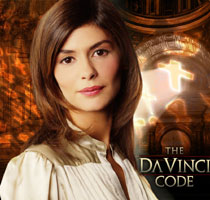
Man: Remember, if we are discovered by the Vatican, we are excommunicated. So should anything go wrong—
Bishop: Yes, I know, I know. This council does not exist. As it never has.
Man: Old friend. Heaven protect you.
Leigh: Keep an eye out for the police. I must say, Robert, I'm quite impressed by the way you withstood my little aeroplane. Did he never tell you? When he was a boy, young Robert fell into a well. How old were you?
Robert: Seven.
Leigh: Treading water all night long, screaming his lungs out to the echoes screaming back. When they found him, he was nearly catatonic.
Young Robert: Help!
Robert: It was a Long time ago.
Leigh: Oh, now, now, Robert. You above all people shouldn’t be one to dismiss the influence of the past.
Robert: Temple Church. I always forget it’s right here.
Leigh: Built 1185 and modern London just sprang up right around it.
Sophie: Tell me, why has the Priory kept the Grail location secret all these years?
Leigh: I don't know. Some say the Priory wait for the heir to reveal himself which is especially odd since Legend suggests he may not know his own true identity.
Robert: Hello?
Sophie: Why do they make them so scary? Oh, it's cold.
Robert: "In London lies a knight a Pope interred." So which tomb has an orb? Those knights with their legs crossed means they’d been to the holy land.
Leigh: Two wear tunics over their armor and two have full-length robes.
Robert: Two are grasping swords.
Leigh: And one--two are praying.
Robert: This one has his arms at his sides.
Leigh: Oh, and this poor fellow has almost disappeared entirely.
Robert: I don't see any orb that ought be on a tomb. "Ought be on his tomb." Are we looking for a missing orb?
Leigh: Maybe.
Robert: These aren't tombs.
Leigh: What? Yes, of course they are.
Robert: No. They're effigies.
Leigh: What?
Robert: Not tombs. There's no bodies here.
Sophie: This place is wrong. Can we go now? We should go.
Robert: Sophie! No!
Silas: Where is the keystone? Do not test me!
Robert: Let her go!
Leigh: Don't you hurt her.
Silas: Give me the keystone! Give it to me!
Robert: Here! Here! Here it is! Here it is. Just let her go, and you and I can-- We'll come to some agreement.
Leigh: Remy.
Robert: Remy. No, no, no. No, put it away. Put it away. They're too close together. You don't have a clear shot.
Remy: Yes, I do.
妙语佳句,活学活用
1. Heaven protect you.
说“愿上帝保佑你”,我们常见到的说法是 God protect you。其实 heaven 也有“上帝,上天”的意思。我们还可以说“Heaven help you! 愿上帝帮助你!”
2. Keep an eye out for
这个片语也写作“keep a sharp lookout for”,意思是“Be watchful for something or someone留心/小心某人某事”,例如:Keep an eye out for the potholes in the road.
如果想要强调语气,可以用 keep a sharp eye out for。
They told him to keep a sharp lookout for the police.
3. Scream one’s lungs out
这个表达法的意思是“大声喊叫,非常响亮的喊叫”,强调“喊得很大声”,例如:The National Day celebrations were a blast, and it was awesome sitting there in the stands and screaming my lungs out, and singing so much that my voice turned hoarse.
用 lung 来表示“喊得响亮”有一个片语,写作 at the top of (one's) lungs,意思就是“尽可能地响亮,非常大声地(喊叫,哭泣等等)”,例如:The babies in the nursery all were crying at the top of their lungs.
4. Spring up
这个片语的意思是“come into existence; take on form or shape 出现,成形”,例如:New buildings are springing up everywhere.
The idea for the book sprang up from a short story.
a love that sprang up from friendship
文化面面观
罗马教廷 Vatican City
Vatican City, independent state (2005 est. pop. 900), 108.7 acres (44 hectares), within the city of Rome, Italy, and the residence of the pope, who is its absolute ruler. Vatican City may be said to correspond politically to the former Papal States, but it was created as a result of the Lateran Treaty of 1929 between Pope Pius XI and King Victor Emmanuel III (negotiated by Cardinal Gasparri and Mussolini), which ended the so-called Roman Question.
History
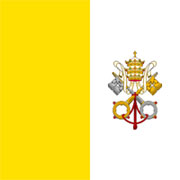 The flag of Vatican City
The flag of Vatican City
The history of the Vatican as a papal residence dates from the 5th cent., when, after Emperor Constantine I had built the basilica of St. Peter's, Pope Symmachus built a palace nearby. The pope usually resided in the Lateran Palace until the “Babylonian captivity” (14th cent.) in Avignon, France. After the return of the papacy to Rome (1377) the Vatican became the usual residence. The Renaissance popes, principally Sixtus IV, Innocent VIII, Alexander VI, Julius II, Leo X, and Clement VII, were great patrons of the arts, and it was they who began to assemble the great collections and to construct the wonderful galleries. Gregory XIII and Sixtus V spent huge sums on the Vatican and also began the Quirinal, a palace that served as the papal residence from the 17th to the 19th cent., was the Italian royal palace from 1870 to 1946, and is now the home of the president of Italy.
Geographic and Political Extent
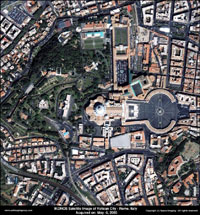 Vatican City
Vatican City
The Vatican City is a roughly triangular tract of land within Rome, on the west bank of the Tiber River and west of the Castel Sant'Angelo. In its southeast corner is the piazza of Saint Peter's Church, surrounded by the splendid colonnade. North of the piazza is a quadrangular area containing administrative buildings and the Belvedere Park. West of Belvedere Park are the pontifical palaces, and beyond the palaces lie the Vatican Gardens, which make up half the area of the little state. The Leonine Wall forms the western and southern boundaries.
In the city of Rome are certain important basilicas, churches, and other buildings to which the Italian government extends the rights of extraterritoriality and tax exemption but not papal sovereignty. The basilicas include San Giovanni in Laterno (St. John Lateran), Santa Maria Maggiore (St. Mary Major), and San Paolo fuori le Mura (St. Paul outside the Walls). The palace of San Callisto at the foot of the Janiculum also shares the immunity of the Vatican, as does the papal summer residence at Castel Gandolfo, in the Alban Hills outside Rome.
Vatican City has its own citizenship, issues its own currency and postage stamps, and has its own flag and a large diplomatic corps. It is open to visitors all year, and the pope receives callers in public and private audiences. It has its own newspaper (Osservatore Romano), railroad station, and broadcasting facility (first established by Marconi under Pius XI). The seven Vatican universities, including the Pontifical Gregorian Univ., are located in Rome. The political freedom of the Vatican is guaranteed and protected by Italy.
Civil and Church Government
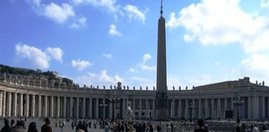 St. Peter's Square, and the obelisk from the Circus of Nero
St. Peter's Square, and the obelisk from the Circus of Nero
The civil government of Vatican City is run by a lay governor and a council, all appointed by and responsible to the pope. The law is the canon law, and the courts are part of the judicial system of the church. The only court special to Vatican City is a court of first instance for civil and criminal cases arising in the city.
The Vatican is above all the seat of the central government of the Roman Catholic Church. Because of the papacy's vast interest in temporal as well as spiritual affairs, an elaborate bureaucracy has been developed over the course of centuries. The pope governs with the College of Cardinals. He may act as he chooses without their consent, but in practice he relies on the cardinals for advice as well as for administration of the church government. The whole administrative body surrounding the pope and responsible to him is called the Curia Romana.
The papal court long had all the characteristics of a royal court, such as elaborate rituals and uniforms, and complex rules of precedence; however, since the reign of Pope John XXIII (1958–63) and the Second Vatican Council, many of the Vatican ceremonies have been greatly simplified. The bodyguard of the pope is the corps of Swiss Guards, founded in the 16th cent. and made up of a small group of Roman Catholic Swiss. Its members wear the splendid Renaissance uniforms designed by Michelangelo.
The Palaces and the Vatican's Treasures
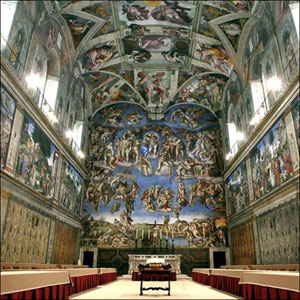 Sistine Chapel
Sistine Chapel
The Vatican palaces are an irregular mass of three-story and four-story buildings, built on long, plain lines and broken by additions and alterations. The papal residence and offices occupy the portion near the colonnade, and the rest is given over to museums and the Vatican Library. The Vatican museums are among the most important in the world; they are the Museo Pio-Clementino, founded in the 18th cent. and containing one of the world's great collections of antiquities; the Chiaramonti Museum, founded in the early 19th cent. and holding a collection of Greek sculptures and Renaissance imitations; the Braccio Nuovo, considered by many to be the most beautiful of all the museums; the Egyptian Museum and the Etruscan Museum, opposite the Braccio Nuovo; and the Pinacoteca Vaticana (opened in 1932), which contains paintings by Giotto, Guercino, Caravaggio, Poussin, and others.
The museums, however, house only part of the Vatican's treasure, for many of the Renaissance and modern paintings are found in the galleries surrounding the various courtyards, such as the Cortile del Belvedere and the Cortile San Damasco. Adjoining the Cortile San Damasco is the building containing the Borgia apartments on the first floor and the Raphael rooms on the second. The works of Raphael and his followers in the building make it one of the most famous artistic monuments in the world. The Vatican Library lies all along the western side of the Giardino della Pigna and Cortile del Belvedere. It is one of the world's richest repositories of ancient and medieval manuscripts in many languages. The principal chapel in the Vatican is the Sistine Chapel, the ceiling of which was painted (1508–12) by Michelangelo.
考考你
将下面的对话译成汉语。
Robert: Let her go!
Leigh: Don't you hurt her.
Silas: Give me the keystone! Give it to me!
Robert: Here! Here! Here it is! Here it is. Just let her go, and you and I can-- We'll come to some agreement.
Leigh: Remy.
Robert: Remy. No, no, no. No, put it away. Put it away. They're too close
together. You don't have a clear shot.
Remy: Yes, I do.
The Da Vinci Code《达•芬奇密码》(精讲之五)考考你 参考答案
1. 你以为他是我男朋友?没有的事。
The Da Vinci Code《达·芬奇密码》(精讲之六)
You think he’s my boyfriend? There’s no such thing.
2. 最近的停车场在半英里外,更糟的是,大雨倾盆一般开始下起来了。
The nearest parking space was half a mile away, and then, to add insult to injury, it began to pour.
3. 她从来都没想过去利用别人的好心。
She would never think of playing on the good nature of others.